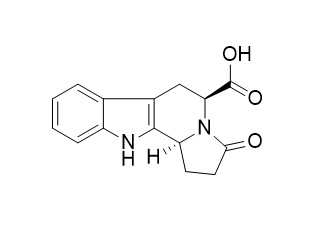Cuscutamine
Cuscutamine has luciferase-inducing activity and can significantly stimulate cancer cell proliferation
Inquire / Order:
manager@chemfaces.com
Technical Inquiries:
service@chemfaces.com
Tel:
+86-27-84237783
Fax:
+86-27-84254680
Address:
1 Building, No. 83, CheCheng Rd., Wuhan Economic and Technological Development Zone, Wuhan, Hubei 430056, PRC
Providing storage is as stated on the product vial and the vial is kept tightly sealed, the product can be stored for up to
24 months(2-8C).
Wherever possible, you should prepare and use solutions on the same day. However, if you need to make up stock solutions in advance, we recommend that you store the solution as aliquots in tightly sealed vials at -20C. Generally, these will be useable for up to two weeks. Before use, and prior to opening the vial we recommend that you allow your product to equilibrate to room temperature for at least 1 hour.
Need more advice on solubility, usage and handling? Please email to: service@chemfaces.com
The packaging of the product may have turned upside down during transportation, resulting in the natural compounds adhering to the neck or cap of the vial. take the vial out of its packaging and gently shake to let the compounds fall to the bottom of the vial. for liquid products, centrifuge at 200-500 RPM to gather the liquid at the bottom of the vial. try to avoid loss or contamination during handling.
mBio.2020, 11(3):e00686-20.
Food Chem.2024, 460(Pt 1):140472.
Molecules.2021, 26(2):E255.
Pak J Pharm Sci.2019, 32(6):2879-2885
Food Sci Biotechnol.2021, 30(2):217-226.
J Pharmacol Sci.2021, 147(2):184-191.
Phytother Res.2019, 33(7):1784-1793
Kyung Hee University2024, 4789969.
ACS Omega.2022, 7(44):40009-40020.
Molecules.2019, 24(2):E343
Related and Featured Products
Planta Med . 2004 Apr;70(4):299-304.
Isolation of a new 15-membered macrocyclic glycolipid lactone, Cuscutic Resinoside a from the seeds of Cuscuta chinensis: a stimulator of breast cancer cell proliferation[Pubmed:
15095143]
While searching for new estrogenic compounds from the plant kingdom, we investigated an extract of the seeds of Cuscuta chinensis (Convolvulaceae) which showed potency for stimulating MCF-7 cell proliferation. A novel resin glycoside, cuscutic resinoside A ( 6) was isolated along with five known compounds from the extract. The structure was deduced from its spectral data as (11 S)-hydroxyhexadecanoic acid 11- O-alpha- L-(4- O-2 R,3 R-nilylrhamnopyranosyl)-(1-->2)- O-alpha- L-rhamnopyranosyl-(1,2-lactone) forming a unique 15-membered macrocyclic lactone. The compound significantly stimulated not only MCF-7 cell proliferation but also T47D human breast cancer cells at a concentration of 10 microM. Along with Cuscutamine ( 1) and kaempferol ( 4), 6 was tested in the transient luciferase reporter assay and was found to have different luciferase inducing activity characteristics from the other compounds. These results suggest that 6 stimulated cancer cell proliferation by a different mechanism from 1 and 4.
J Sep Sci . 2018 May;41(10):2169-2177.
Application of off-line two-dimensional high-performance countercurrent chromatography on the chloroform-soluble extract of Cuscuta auralis seeds[Pubmed:
29450982]
In this study, the chloroform-soluble extract of Cuscuta auralis was separated successfully using off-line two-dimensional high-performance countercurrent chromatography, yielding a γ-pyrone, two alkaloids, a flavonoid, and four lignans. The first-dimensional countercurrent separation using a methylene chloride/methanol/water (11:6:5, v/v/v) system yielded three subfractions (fractions I-III). The second-dimensional countercurrent separations, conducted on fractions I-III using n-hexane/ethyl acetate/methanol/water/acetic acid (5:5:5:5:0, 3:7:3:7:0, and 1:9:1:9:0.01, v/v/v/v/v) systems, gave maltol (1), (-)-(13S)-Cuscutamine (2), (+)-(13R)-Cuscutamine (3), (+)-pinoresinol (4), (+)-epipinoresinol (5), kaempferol (6), piperitol (7), and (9R)-hydroxy-d-sesamin (8). To the best of our knowledge, maltol was identified for the first time in Cuscuta species. Furthermore, this report details the first full assignment of spectroscopic data of two Cuscutamine epimers, (-)-(13S)-Cuscutamine and (+)-(13R)-Cuscutamine.



